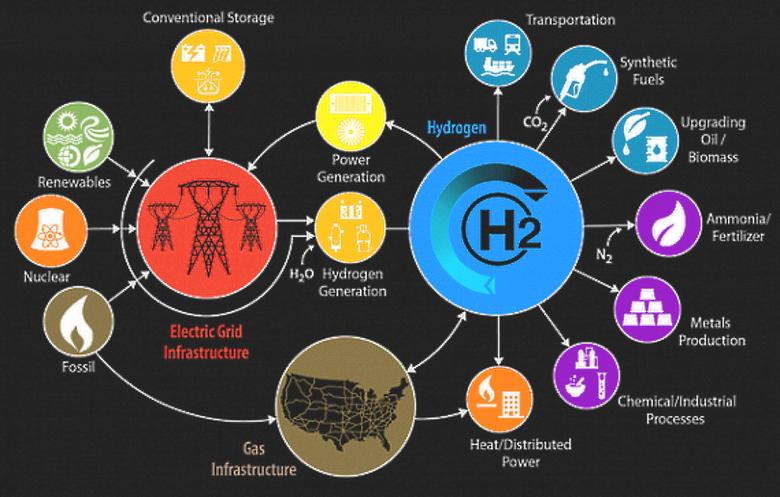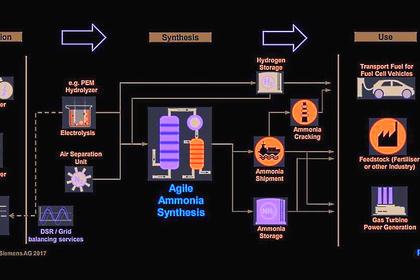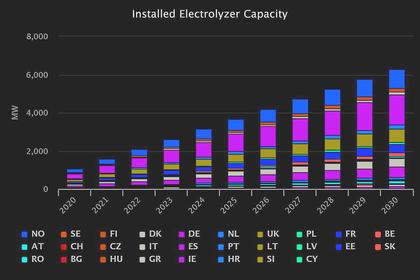
GREEN HYDROGEN COST & SECURITY

GTM - NOVEMBER 30, 2020 - Can carbon-free hydrogen augment, or even replace, the fossil natural gas running through pipelines to fuel furnaces, boilers, stoves and other building applications today?
Or will the effort get bogged down in challenges related to pipeline safety and upgrade costs, loss of energy density, the long-term cost discrepancies compared to electrifying natural-gas-fired heat and appliances in buildings, or the pressure to direct green hydrogen to hard-to-decarbonize sectors?
Natural-gas utilities around the world are seeking real-world answers to these kinds of questions. Some of the most advanced efforts are underway in the U.K., where utilities including National Grid and Scottish Gas Network are blending hydrogen into pipelines not just to fuel power plants or industrial processes but also to serve homes and businesses.
“We’ve got hydrogen in 20 percent blend already going into one very small network in the U.K., and consumers are saying they notice no difference” in terms of performance of gas-fired appliances, Antony Green, National Grid U.K.’s hydrogen project director, said in an October interview. “That’s a good sign.”
U.S. green hydrogen pilots and proposals
U.S. utilities with net-zero carbon goals are starting to catch up, bolstered by federal funding to solve challenges with increased hydrogen concentrations in existing pipelines. Green hydrogen to replace natural gas for power generation is likely the first cost-effective application.
Gulf Coast utility Entergy wants to use existing oil industry hydrogen pipeline networks and underground salt caverns to ship and store hydrogen to replace natural-gas-fired power. A similar underground cavern in Utah could be the site of a regionwide green hydrogen production and storage complex being planned by a consortium including Mitsubishi Power, the state-owned Intermountain Power Agency and the Los Angeles Department of Water and Power.
But hydrogen in distribution pipelines could also help decarbonize industrial processes dependent on natural gas, or even building heating and cooking, utilities contend. In New York, National Grid has launched a project with the New York State Energy Research and Development Authority and Stony Brook Institute to study the potential to integrate and store renewable hydrogen in its existing gas infrastructure.
And this week, Southern California Gas and San Diego Gas & Electric, subsidiaries of the California utility holding company Sempra Energy, asked the California Public Utilities Commission to approve a pilot project that would test pipeline injection of green hydrogen blends from 1 percent to 20 percent, starting next year.
The CPUC is one of several state utility regulators considering hydrogen blending strategies, and projects like Sempra’s are a “big deal, because they’re developing a hydrogen injection standard,” Dajani said. As efforts like these expand, federal agencies — namely, the Federal Energy Regulatory Commission — will need to manage how this could become part of the interstate natural-gas pipeline network, she added.
Hydrogen pipeline challenges: Engineering, safety and costs
But replacing natural gas with hydrogen has its pitfalls, starting with how it affects the pipelines it travels in and the appliances that use it. On the pipeline front, "hydrogen embrittlement” can weaken metal or polyethylene pipes and increase leakage risks, particularly in high-pressure pipes, according to a 2013 study from the U.S. Energy Department’s National Renewable Energy Laboratory (NREL).
“Hydrogen can attack the metal structure under certain circumstances, certain pressures, certain concentrations,” National Grid’s Green said. “That’s an area the materials scientists are trying to tackle” as part of the U.K.’s hydrogen research.
In the U.S., the HyBlend project involving NREL and five other DOE labs intends to examine the long-term effects of hydrogen at different blends on different pipeline materials and create publicly available models for industry use. This kind of research will help determine how much it will cost to upgrade existing pipeline networks to make the shift.
Hydrogen also “burns very differently” than methane, said Jussi Heikkinen, the Americas director of growth and development for Wärtsilä Energy, which is investing in engines that can run on 100 percent hydrogen. “It burns almost as an explosion. […] It’s a blast, and then it’s done.” That’s good for efficient conversion of gas into heat, but it also brings safety and engineering challenges, he said.
“When you go beyond 25 percent hydrogen in the fuel, in most places in the world, you’re no longer able to use the same equipment. Electronics, for example, must be explosion-proof. […] There should be no sparks because hydrogen ignites with almost any air-to-fuel ratio.”
Hydrogen is also about three times less energy-dense than methane. That means that as the ratio of hydrogen rises, the volume of energy being delivered through the same pipelines decreases, he said.
Green hydrogen versus building electrification
Making green hydrogen using carbon-free electricity also costs four to six times more than making hydrogen from fossil fuels. Those costs are expected to fall with advances in electrolysis efficiency, lower costs of renewable energy to power them, and economies of scale from the industrial hubs being built around the world.
Even so, governments and industry partners will be hard-pressed to direct green hydrogen to its cost-effective uses. Its combination of low energy density and high cost in pipelines could make it a tough sell compared to electrifying heating, cooking and other typical uses of natural gas in homes and businesses.
The Rocky Mountain Institute think tank supports green hydrogen for power generation and decarbonizing challenging sectors like steel production, shipping and long-distance trucking. But it also supports electrification as more efficient for most building uses.
In California, where a growing number of cities and counties are banning natural gas in new buildings, environmental groups pushing for a similar statewide mandate worry that Southern California Gas is using the promise of green hydrogen to secure future natural gas infrastructure investments.
The state’s biggest natural-gas utility is under state regulator investigation into its use of ratepayer funds for anti-electrification advocacy, and its proposals to meet the state’s carbon-free by 2045 mandates through alternatives such as green hydrogen and biogas have been challenged as highly unlikely to grow to a scale needed to replace fossil fuels.
The carbon reductions to come from blending 15 to 20 percent hydrogen in natural-gas pipelines may be relatively minimal, said Jeffrey Rissman, industry program director at the climate policy think tank Energy Innovation. At the same time, he said, “Increasing the market for green hydrogen might help drive down costs by incentivizing [research and development] and achieving returns to scale."
National Grid operates electricity and gas networks across the U.S. Northeast. But its gas pipelines deliver between two to four times the amount of energy as its electricity transmission and distribution networks do on any given day, with wintertime driving the biggest demand for heating, said Don Chahbazpour, National Grid’s "future of heat" regulatory strategy director.
“Decarbonizing heat is very challenging to do, especially in areas that we serve — New York City, Boston — with a lot of old buildings,” he said. “When you do electrify heat, the questions become much thornier.”
-----
Earlier:


















